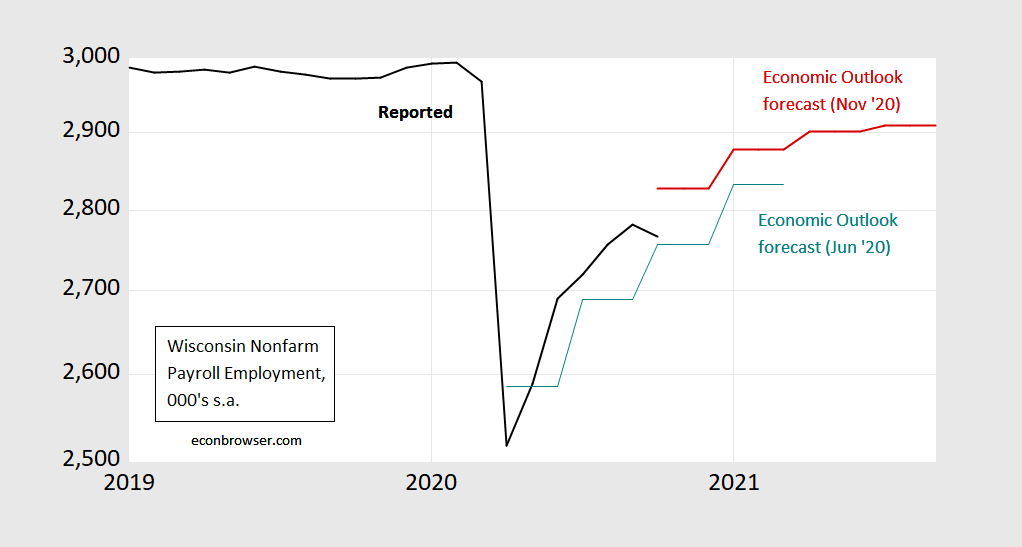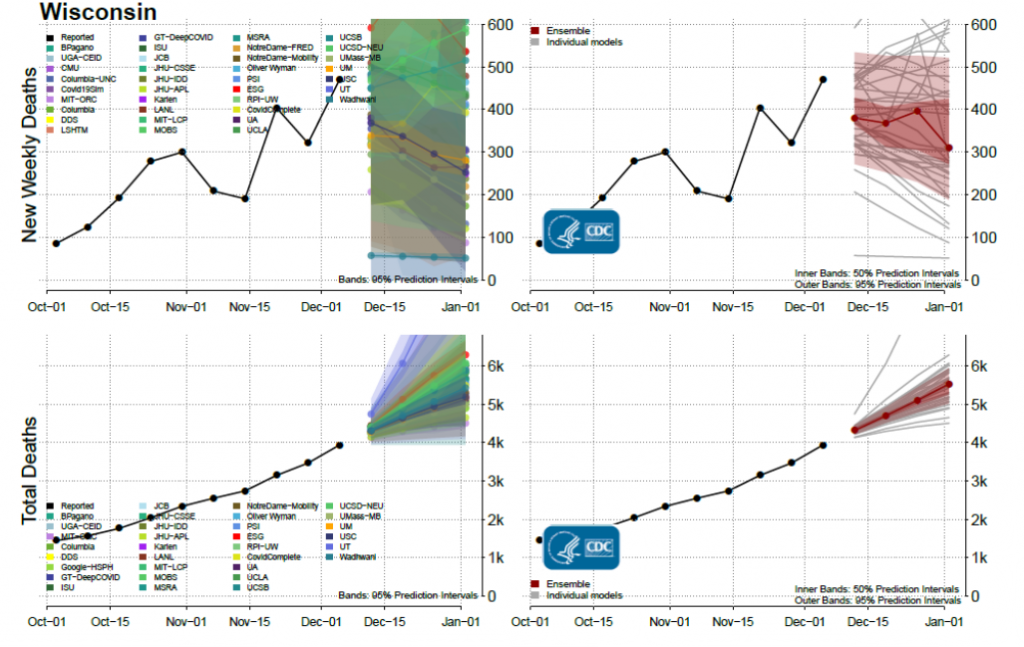The Wisconsin Department of Revenue has released its Economic Outlook, dated November 22nd. The forecasts incorporate assumptions that include: “November IHS Markit forecast shows a slowing down of the economic recovery in the last quarter of 2020 and beginning of 2021. Several high-frequency indicators point to a further deceleration in October, but the forecast does not include a double dip. ….Wisconsin personal income growth accelerated in 2020 pushed by the federal stimulus funds, but it’s expected to decline 1.9% in 2021, as the fiscal stimulus fades. …The current forecast assumes no further fiscal stimulus and that a vaccine will be available by mid2021.”
Figure 1: Wisconsin nonfarm payroll employment (black), forecast from November Economic Outlook (red), from June Economic Outlook (teal), all in thousands, s.a. Source: BLS, Department of Revenue, June, November.
Notice the drop in employment in October’s numbers. It’s unclear whether this outcome is a product of measurement error or representative of an actual drop in activity (that observation point is preliminary).
The October figure pertains to the payroll week ending the 14th, so it’s already a bit out of date. November’s figure won’t be out for approximately another week, on the 18th from BLS). With the pandemic surging in Wisconsin (recent peak fatalities was around December 7th, using a 7 day trailing moving average – source), we might see continued sideways trending. The Dallas Fed’s Mobility and Engagement Index suggests this might be the case.
Figure 2: Mobility and Engagement Index by day (blue) and 7-day centered moving average (brown). Source: Dallas Fed and author’s calculations.
Looking forward in the next few months, a lot will depend on the evolution of the pandemic (as much as the extension or not of enhanced unemployment insurance and pandemic assistance — DoR forecast assumes no further support). The CDC’s ensemble models indicate that Wisconsin might be past the (local) maximum in terms of fatalities — but there are very large confidence intervals.
Source: CDC, report of December 7, 2020. Accessed 12/10/2020.
After about seven months of inaction, Republican legislators in Wisconsin have come forward with legislative proposals to address the pandemic’s impact (Capital Times). It’s difficult for me to discern the positive impact on economic activity and/or public health that would result from the proposed measures, but at least there is some indication that Republican policymakers are now considering doing something.



You’ve seen today’s jobless claims. Contrary to assertions by one of your commenters, claims do carry substantial information. The 4-week average has turned higher. A continued rise would indicate a concurrent drop in output.
That’s nationwide, of course. I. suspect you have a rwad on Wisconsin’s jobless claims.
Gonna start to look like the most jack-A$$ looking “V-shaped recovery” you’ve ever seen in your life. Or maybe a “V-shaped recovery” only one jack-A$$ could see.
At least for those of us not Trumpsters, it was forecast to be a V that would flatten, and that is exactly what it has become, with a possible dip after the flattening, but a V that flattens before that.
Are you still unable to see that, Moses? And what was your forecasted pattern again, the one you communicated to your secret super friend that cannot be publicly revealed? Right. You were asked to put up or shut up, but, of course, you continue to do neither.
@ Barkley Junior
“V that would flatten”. Gee, gosh, that sounds like such “highly technical insider jargon”. The kind only a mathematical economist could understand with his special narcissist bequeathed powers. Gee, I’m kinda slow, which chapter/page is that mentioned in Blanchard’s Macro text?? And can you remind us the date you originally used that??—literally months after everyone knew it wasn’t going to be a “V-shaped recovery” and you were using your bare hands in an ill-fated attempt to smear off the egg yoke all over your face??
Sorry, Moses, on this matter it is you with “egg yolk all over your face.” The only person who has remotely supported your denial that the recent pattern of GDP has been a “V that flattens” has been Not Trampis, whose complaint is that any letter pattern must be a dictionary perfect replica, and indeed he is right that the pattern we see is not that perfect. It just looks a lot like a V, which months ago many here affirmed, but I am not going to dredge through past records to bring all that up. None of those people are now talking about it because it is ancient history now, Moses, but that was the widely agreed upon view here, and everybody aside from you is beyond this.
You lost on this, boy. Time to move.
Read. Not read.
As a courtesy to Menzie, I was gonna put this link in an older thread that was more politically/sociologically based. But because roughly the last 10 comments in that thread was Barkley Junior responding to himself, I decided to put this where someone might actually read it:
https://publiceditor.blogs.nytimes.com/2016/03/17/new-york-times-bernie-sanders-coverage-public-editor/
I first became suspicious of the NY Times’ objectivity after a huge demonstration at the state capitol. The event was covered in the Sunday Times and turned out to be a wholly fictionalized account of what it was about.
It took another 40 years for me to come to the conclusion that this type of coverage was not an exception but standard operating procedure. Judy Miller and the Times’ unabashed, uncritical boosterism for the Iraq War was the final straw.
Lector cave!
I like the NYT paper overall, I’d rate it top 10 publications based out of America. Truth be told I view reading the NYT (especially hardcopy) as one of the true joys of life. Newspapers remind me of my Dad, who I remember mostly (at least in between the ages of 4–13) as mostly mumbling to me from behind a newspaper apparently thinking that looking at me was a great inconvenience in life. And I’d tell you I think I’m very good at ferreting out quality journalism from mediocre, but doesn’t everybody believe themselves as such?? But you can see little NYT biases creep in here and there. Not usually too much in what they report, but they know there’s a lot of power in intentional omission. That story is a prime example. They wanted to discuss how none of Bernie’s ideas would ever become reality. Well fine, let’s take that as “true”. Did they think Hillary’s ideas were that much more achievable?? Maybe, if you consider following her corporate puppet masters as more apt to get something done. Anything that is worth a G*ddamn, the American working man in this country has had to fight for, the fact that Hillary’s policy agenda was more “attainable” isn’t necessarily a “selling point”. It just means her soul is cheaper to purchase.
Yeah, I read the Times, too. But I am now very mindful of any hint of an agenda, particularly when it comes to foreign policy and domestic politics. Once your aware of it, it’s interesting to watch the deviousness of their tricks and subterfuge…like in the article you linked to.
But, I have to admit, they do have a few first rate writers, such as Binyamin Appelbaum:
https://www.nytimes.com/2020/09/18/opinion/milton-friedman-essay.html
It seems that academics involved in public policy need to be evaluated at a couple very distinct levels—as academics they may be brilliant; but their influence on public policy may end up being catastrophic, resulting in unfettered laissez faire capitalism and rampant inequality.
You of all people whining about side conversations and someone being misrepresented. You are even funnier than a Trump tweet!
@ pgl
Maybe since you love one sentence blurts, you should spend more time on Twitter. We weren’t discussing “side conversations” (did poor pgl feel “left out”??), we were discussing newspapers and journalistic integrity. Go back to reading TPM, they may have copy/pasted a story originally sourced by Politico that was posted 72 hours prior. You’re going to feel NYC “man about town” when reading yesterday’s news TPM swiped from other sites, and I don’t want to snatch away your big thrill of the day.
In reference to commercial journalism, “ economic issues were looked at from the perspective of the dominant interests of the Republican and Democratic parties, which reflected the dominant commercial interests in society. Foreign policy was looked at pretty much the same way by both parties: the United States was a benevolent empire, had the right to rule the world as it saw fit, and the military was a necessary part of it. It wasn’t really up for debate in the US news media in the 20th century. That was just a given, certainly in the second half of the 20th century. And during that period, we had a blossoming, resource-rich journalism for many of those decades. Yet still, its coverage of war and peace matters and of the economy tended to skew to a very narrow range of the sort of people who were leading both political parties and the economy.”
https://www.nakedcapitalism.com/2020/12/robert-mcchesney-the-decline-of-american-journalism.html
Commercial interests…explains why establishment newspapers like the NYT were so gung-ho about the Iraq War and so opposed to Bernie, as were the various serious economists who were granted bully pulpits on their opinion pages.
McChesney is basically telling people to look for the agenda behind the news stories…and it isn’t the public interest or the common good.